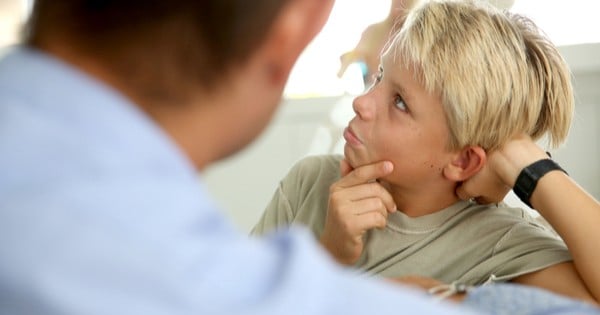
You can learn a lot by observing your son in his My Gym class.
As a part of the warm-up routine, he was supposed to be standing outside the Big Red Circle and stretching his arms above his head. Instead he was running in figure-eights and swerving within inches of colliding into his classmates.
He looked like a Japanese kamikaze pilot, and my only consolation was, no parents were watching, and his teachers were being very patient.
I imagine they’d seen his “type” in their classes, a hybrid of the Energizer Bunny and the Scarecrow from The Wizard of Oz. A kid who has a floppy body like an astronaut in space and has trouble staying tethered to the ground.
I was confident that I knew the reason for his kamikaze behavior. He is hypersensitive to loud music. Loud noises such as lawnmowers, car horns, motorcycles, vacuum cleaners, and cranked-up music in a My Gym class (to add some energy to the class) throw his senses totally out of working order.
Observation #1: My son, who is on the autism spectrum, has sensory sensitivities to noise and chaotic environments with lots of stimulation.

Author Photo: My son in ballpit.
Fortunately, his teacher put her hand on his shoulder. This calmed his body down, and he stood outside the circle. I wrote a Mental Note to myself: Place a hand on his shoulder to calm my son’s body whenever he’s overstimulated.
Then I picked up a magazine to read, hopeful my son’s body would remain regulated, so I could enjoy one of the rarest commodities of the parent of a four-and-half-year-old: Taking a parenting break.
One minute later, my son’s feet were on the back of a boy as he waited his turn for an activity, and his legs were fully extended. He was pushing him forward like he was doing a leg press exercise at a Gold’s gym.
So I slid over the counter, gave him a warning, and slid back over. Then he walked on two poles, with his teacher’s support, with foam padding on the bottom. It looked like my son was walking on two gigantic purple Q-tips.
Observation #2: My son and autistic kids sometimes need sensory input if they’re overstimulated to regulate their bodies. Now you understand if you’re the parent of a neurotypical child and you see a kid who crashes and burns.
The Egg Roll was next: Grab your knees, pull them to your chest, wobble backward and forward and side to side like a dozen eggs, but the directions were shouted too fast to process the information and carry out the directions.

Photo by the author.
Stinky Feet was next: Smell your feet, grab soap and water, smell your feet again, say PEE-YOU, grab baby powder, sprinkle feet with baby powder, smell feet again, sneeze, fall backward. It was shouted to fast for my son to follow.
He laughed as his peers smelled their feet, shouted PEE-you, sneezed, and fell backward, and my brain became barraged by a series of questions:
How concerned should I be about my son not being able to follow directions with multiple steps? To not be able to wobble like an egg? Or not be able to grab his feet, smell and sprinkle them with baby powder, and fall backward and sneeze? Or to his super hypersensitivity to highly-stimulating environments with lots of kid activity and noise?
Observation #3: M y son and autistic kids (and some non-autistic kids) have a hard time doing tasks with multiple-step directions —called executive functioning — especially if the directions are shouted at a fast tempo.
I thought of a wooden puzzle map of the United States my brother’s family gave my son this Christmas with pieces shaped like each state. Without me being aware of it, he learned the locations of all fifty states and their capitals.
I heard him saying the states and capitals to himself one day as I walked by his room — the capital of Kentucky is Frankfort, the capital of Wyoming is Cheyenne, the capital of Ohio is Columbus—and I listened outside his bedroom door.
“What’s the capital of South Dakota?”
“Pierre.”
“What’s the capital of Texas?”
“Austin.”
“What’s the capital of Vermont?”
“Montpelier.”
“What’s the capital of Arkansas?”
“Little Rock.”
I quizzed him on all fifty states, and he knew every state and capital, even pronouncing each one correctly. I remembered he has an electronic United States map, so I guess that he’s been learning states and capitals for a while.
Observation #4: My son and autistic kids gave a knack, or brain wiring, to learn things in categories. States/capitals. Movie characters/actors, etc.
My mind raced next to my son learning to read at four. A kindergarten teacher told me about a phonics website Starfall.com. Letters and sounds are a category like states and capitals. Every day, when I came home from work, my son would say to me as I entered the door: “Dad, let’s do Starfall.com.”
So we squeezed in a leather chair in the living room, and he loved to watch a bear with a blue backpack pirouetting like a ballerina or to see ants scurrying across the screen as he said the sounds for each of the letters of the alphabet.
He progressed from sounds of letters and consonant blends to one, two, and three-syllable words, and in three weeks, he read stories on Zac the Rat and a Tin Robot and street signs, as well as signs in a shopping plaza up the street.
Observation #5: My son is a didactic learner. Though I was sitting next to him, it was obvious he was learning to read on his own without a teacher.
(Of course, as a stay-at-home mom, my wife read stories to him at home, and I’m sure this influenced his reading.)
And so as I thought about my son’s difficulty with the Egg Roll and Stinky Feet, I reached this conclusion: I will focus on what my son does well, and if his development is delayed in other areas, I will let him progress at his pace.
The mirror theory
A week later, I came across an article by Temple Grandin. You know her. She is one of the first openly autistic adults renowned for her designs for equipment in the cattle industry, a university professor, and an autism advocate:
So, whenever I see my son push a kid with his legs in his My Gym class or have difficulty following the directions shouted crazy fast by his teachers, I will think about how this sensory challenge could also mirror a special ability.
Famous autistic people
I will think of Albert Einstein, who didn’t talk until four and struggled to socialize as an adult, watching trains whiz past him as he formulated his theory of relativity, or I will think of Temple Grandin, diagnosed with brain damage at two, observing the behavioral patterns of cattle on her aunt’s farm as a teenager to one day invent a humane method for cattle to be slaughtered.
I will think of Dan Aykroyd, Lewis Carroll, Emily Dickenson, and the many other people in history who displayed autistic traits and are thought to have been on the autism spectrum: Charles Darwin, Thomas Jefferson, Steve Jobs, Wolfgang Amadeus Mozart, Michelangelo, Sir Isaac Newton, Andy Warhol, Nikola Tesla, James Joyce, Stanley Kubrick, and Hans Christian Anderson.
I will think of Anthony Hopkins, Jerry Seinfeld, Tim Burton, Bill Gates, and Elon Musk — those who have either been diagnosed with autism or are thought to be on the spectrum.
Final Thought
In short, I won’t worry about what my son can’t do like the Egg Roll and Stinky Feet. I will remember the things he can do well such as his ability to learn all 50 states and their capitals or decoding words to learn how to read.
—
This post was previously published on A Parent Is Born.
***
From The Good Men Project on Medium
 What Does Being in Love and Loving Someone Really Mean? What Does Being in Love and Loving Someone Really Mean? |
 My 9-Year-Old Accidentally Explained Why His Mom Divorced Me My 9-Year-Old Accidentally Explained Why His Mom Divorced Me |
 The One Thing Men Want More Than Sex The One Thing Men Want More Than Sex |
 The Internal Struggle Men Battle in Silence The Internal Struggle Men Battle in Silence |
Join The Good Men Project as a Premium Member today.
All Premium Members get to view The Good Men Project with NO ADS.
A $50 annual membership gives you an all access pass. You can be a part of every call, group, class and community.
A $25 annual membership gives you access to one class, one Social Interest group and our online communities.
A $12 annual membership gives you access to our Friday calls with the publisher, our online community.
Register New Account
Log in if you wish to renew an existing subscription.
Need more info? A complete list of benefits is here.
—
Photo credit: Scott Butwell
The post My Son the Kamikaze Pilot appeared first on The Good Men Project.